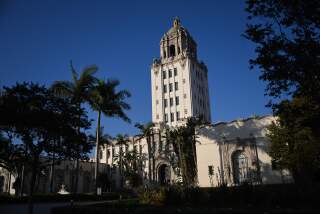Plan to Save Beverly Hills S&L; Studied : Backers Say Strategy Could Be Model for Other Ailing Thrifts
- Share via
Federal savings and loan regulators are studying a plan to rescue Beverly Hills Federal Savings & Loan Assn. by spinning off the thrift’s healthy loans into a new financial institution and liquidating the bad assets through a separate company, according to sources in the savings and loan industry.
If the plan works, its supporters say, it could be used as a model for nine other savings and loan associations in California taken over by federal regulators this year. Most of these, like Beverly Hills Savings, have been placed in receivership but allowed to remain open for business under new management.
The strategy, called the “good bank/bad bank” plan, has powerful industry support by those who see it as another way to conserve the scarce resources of the Federal Savings & Loan Insurance Corp. The FSLIC, which insures customer deposits up to $100,000, is also the bad-loan-liquidation agency for the nation’s 3,200 federally insured savings and loans.
The hope is that FSLIC will sell the good assets at a profit that will more than offset the expected losses on the bad loans. Although federal regulators declined comment, they have indicated previously that they favor the concept if legal and accounting questions can be resolved.
Too Good to Be True
Critics, however, say the plan sounds too good to be true and ignores key accounting and financial issues.
“Who is kidding whom here?” asked one real estate liquidation specialist in Orange County. “This would be like transferring all my family’s debts to my wife and saying: ‘Look at me. I’m healthy.’ ”
A similar plan was proposed earlier this month by William J. Popejoy, chairman of American Savings & Loan Assn., which is not in receivership but has about $2.5 billion in troubled or high-risk loans. Stockton-based American is the largest savings and loan in the nation.
One industry consultant says he expects federal regulators to approve the plan for Beverly Hills Savings “within a month.” The Federal Home Loan Bank Board took control of the S&L; last April after the financial institution announced that its net worth had been wiped out by heavy real estate loan losses.
One of the first to talk about the good bank/bad bank plan in public was R. G. Taylor, chief executive the Las Vegas-based First Western Savings Assn. and the new board chairman of Beverly Hills Savings.
Industry Solution
Taylor, at a gathering of industry officials in San Francisco earlier this month, touted the concept as “a pilot (that) could be a solution for the problems of our industry.” The bad banks would try to liquidate their real estate loans within five years, he said, while the surviving healthy institutions would sell stock to the public to offset the losses.
However, the good bank/bad bank concept is getting a skeptical reception from those who wonder how the bad banks will be funded and who will take the accounting losses when the troubled loans are sold off at less than than book value.
According to Taylor, the bad banks would get their operating capital from the 12 Federal Home Loan Banks, which are well capitalized. Both the home loan banks and the FSLIC are a part of the Federal Home Loan Bank Board system. Proponents also say the FSLIC will actually make money if the liquidations take place gradually over several years and are supervised by real estate experts who won’t unload the properties at fire-sale prices.
But Peter Stearns, the former director of the FSLIC who resigned last month, says the bad real estate loans are in much worse shape than most people realize. The losses on problem loans at some S&Ls; in Texas and California will run as high as 70%, he said in a recent interview.
Stearns estimates that the 10 California associations have about $4 billion in bad real estate loans. The huge losses from selling them would be too much for the FSLIC to absorb, he says.
The most troublesome loans, regulators say, are the so-called acquisition, development and construction (ADC) loans--often condominium projects and shopping centers--that have allowed S&Ls; like Beverly Hills to reap initial large profits from high interest rates and up-front fee income.
But the loans have had a very high delinquency rate because they have have been ill-conceived and sloppily put together.
Poorly Written Loans
“Poorly underwritten loans for construction or development are the single largest cause of FSLIC’s problems,” Bank Board Chairman Edwin J. Gray noted in a recent speech in San Francisco.
Among those who believe the good bank/bad bank concept will work are David Smith, a well-known industry trouble shooter who has his own consulting firm in Pasadena, and Stan Ross, a partner in the Los Angeles-based consulting firm of Kenneth Leventhal & Co.
Ross likes the plan because it is so uncomplicated.
“This is such a simple plan that I really believe in it,” he says. “Some of the best concepts are just plain vanilla.”
There is also the feeling that regulators don’t have anything to lose by trying the good bank/bad bank approach.
“If it doesn’t work,” says an industry consultant, “you just put everything together again.”
More to Read
Inside the business of entertainment
The Wide Shot brings you news, analysis and insights on everything from streaming wars to production — and what it all means for the future.
You may occasionally receive promotional content from the Los Angeles Times.










